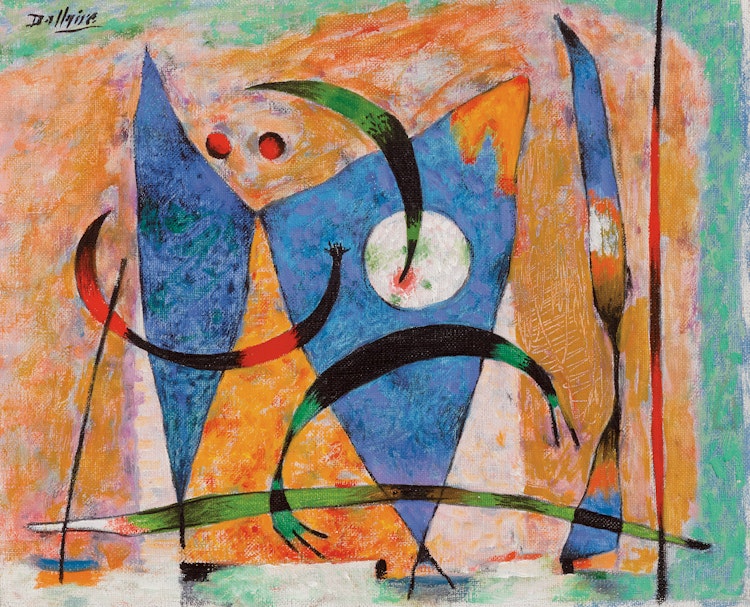Papillon by Jean-Philippe Dallaire

Jean-Philippe Dallaire
Papillon
oil on canvas
signed upper left; signed, titled, dated 1958 and inscribed “Paris” on the reverse
8.75 x 10.75 in ( 22.2 x 27.3 cm )
Auction Estimate: $18,000.00 - $22,000.00
Price Realized $26,400.00
Sale date: May 30th 2024
Dominion Gallery, Montreal
Private Collection, California
Walter Klinkhoff Gallery, Montreal
Private Collection, Montreal
After the war, he returned to Canada, working as an art teacher, cartoonist, and self-employed artist and muralist. He both drew and painted, and made use of cardboard, canvas board, linen or cotton canvas, chipboard and plywood in his work. Dallaire is noted for his self-education and originality. His style was constantly evolving and being reinvented, and Dallaire incorporated his many interests into his work, including the theatre, puppetry, and fantastical creatures.
“One could say that I do not take life seriously. I always had a fondness for birds, little flags and the texture of fabrics. Perhaps it is a bit decorative, but so what”, Dallaire is quoted as saying in 1957, which speaks to this wide range of influences as well as his indifference to artistic trends. “Papillon” was painted in 1958, at the height of the artist’s career. The large canvas presents blue abstract forms both linear and planar, floating across an ochre ground. These shapes appear to be in movement, yet it is unclear if they are meant to represent human or animal life or another organism. Taking a cue from the work’s title, we may be able to discern a butterfly shape in the two largest blue triangles. This lively abstract canvas bears similarities to Miró’s paintings of animated biomorphic forms, as well as to the early Surrealists’ themes of dream imagery and drawing from the unconscious.
Share this item with your friends
Jean-Philippe Dallaire
(1916 - 1965)
Jean-Philippe Dallaire, the painter, illustrator and professor was born at Hull, Quebec on June 9, 1916. He was raised in a working-class family of 15, and started drawing at age 11. He studied art at the technical school in Hull in 1934; at the Toronto Central Technical School under Charles Goldhammer, Peter Haworth, and sculpture with Elizabeth Wyn Wood in 1935. He studied the Old Masters at Boston in 1936.
From 1936 to 1938 he painted religious murals for the Dominican Fathers near Ottawa and at Fall River, Massachusetts and about this time did large figure studies on the walls of Madam Burger’s restaurant destroyed by the fire which levelled her first famous earring house. In October 1938, with the support of a Quebec government grant, Dallaire went to Paris and studied under Maurice Denis, Georges Desvallières and at André L’Hote’s school. He became familiar with the work of Picasso and the surrealists and met Alfred Pellan.
During World War Two, while under the German occupation in France he was a prisoner at St-Denis, outside Paris. He continued to paint in his confinement, but his wife was released after six months. While interned he come to know Frank Pickersgill who escaped but later died in another camp. On his return to Canada in 1946, he taught painting at the Ecole des Beaux-Arts in Quebec City. He later worked for the National Film Board in Ottawa illustrating animated films. He also filled commissions of designing tapestries.
Writing on the artist, Donald W. Buchanan brought out that Dallaire’s art had been affected by years of internment, by cubist analysis of form, the decorative possibilities and limitations of tapestry design in which he had specialized, and his sensitivities to the myths of French Canada against the realities of Canada today. Buchanan further wrote, “. . . he is obtaining a firm monumentality of design in his canvases. The question is, will he continue to achieve this without losing that gay freedom of detail which has always been such an attraction in his smaller works . . .” At the beginning of the same article Buchanan had spoken of Dallaire’s fantasies often verging on comedy in which melancholy lurked.
He then lived and painted in Montreal from 1957 to 1959. In '59 he moved to Europe permanently. He died of heart failure in 1965, thus ending prematurely a brilliant career. He is represented in the permanent collections of the National Gallery of Canada, the Art Gallery of Ontario and the Museum of the Province of Quebec. Dallaire's works show varied stylistic influences and are always recognized by their draftsmanship and spontaneity in subject and use of colour.
Source: "A Dictionary of Canadian Artists, Volume I: A-F", compiled by Colin S. MacDonald, Canadian Paperbacks Publishing Ltd, Ottawa, 1977

